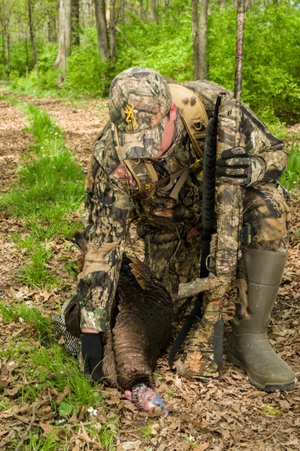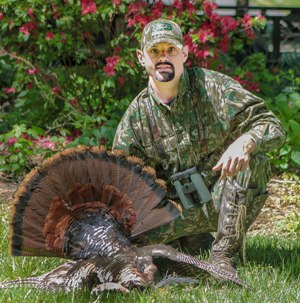 When I’m hunting, I try to move as quietly as possible through the woods. I don’t give turkey calls but instead use locator calls, like crow and owl calls. When you use hen calls when you’re attempting to locate a tom turkey, you don’t know where that gobbler may be. He may be much closer than you think and may come running in to you, and you’ll spook him. So, if I spook a tom on Saturday, I may not have a turkey to hunt on Sunday, since there’s only 390 acres.
When I’m hunting, I try to move as quietly as possible through the woods. I don’t give turkey calls but instead use locator calls, like crow and owl calls. When you use hen calls when you’re attempting to locate a tom turkey, you don’t know where that gobbler may be. He may be much closer than you think and may come running in to you, and you’ll spook him. So, if I spook a tom on Saturday, I may not have a turkey to hunt on Sunday, since there’s only 390 acres.
I try not to use hen calls, unless I hear a gobbler answer my locator calls. When I can’t make a turkey gobble, I’ll go to one of the two food plots on the land where I know the turkeys usually will show up. I’ll set up there to try and take a gobbler. I may sit on that spot for an hour before I call. Then I only may call one or two times before putting my slate call away.
Just because I don’t hear a turkey gobble doesn’t mean I’ll necessarily leave that area, especially when I know I’m in a place where turkeys want to be. I may sit on that same spot for 45 minutes or another hour before I decide to move. Often a turkey will move into that food plot without gobbling. I’ve taken a number of silent turkeys using this tactic, but most of the time, I can get those birds to gobble. Also, I may have been sitting on a spot for 30-45 minutes after I’ve yelped, and a gobbler may come in silent, and I’ll take him.
I have struck out before on Saturday on my 390-acre spot, then taken a blind and my decoys and set-up on Sunday and harvested a turkey that may have come in silent with my bow. In North Carolina where I live, you only can hunt turkeys with a bow on Sundays. So, just because I don’t hear a tom gobble on Saturday, I don’t go home. Instead I change tactics, use a portable blind and decoys and try to take a gobbler with my bow.
Too, sometimes the turkeys will gobble their brains out on Saturday and not gobble at all on Sunday. I’ve always remembered the old saying, “Patience will kill you more turkeys than calling ever will.” After hearing a tom gobble to my locator calls, then if I give hen calls, and a tom gobbles back to those hen calls, I’ll know where he is. He understands too where I am. So, many times, if I just remain where I’ve set up, at some time during the day, that gobbler will return to that spot, looking for me. Once that turkey gobbles back, I have to force myself to not call any more. I just need to sit where I am, because that gobbler expects me to come to where he is. Once I don’t go to him, often I’ll hurt his feelings, and he’ll come to me to see why I haven’t come to him. My strategy is to wait the turkey out, don’t give him another call and force him to move to me. I think one of the biggest mistakes in turkey hunting is we may call too much, or we move when we think a turkey should have come to us by a certain time, and he hasn’t. Most people will leave after 30 minutes, after they’ve heard a gobbler answer their calls.
So far I’ve learned that the easiest gobblers for me to take are the ones I call to once or twice and not call to them again. Those gobblers generally will come in silent, but I’ll at least get to see them and get a shot. So, I guess the old way – call two or three times and then throw away your call – still works.
Day 4: Wading Water to Get a Turkey



























